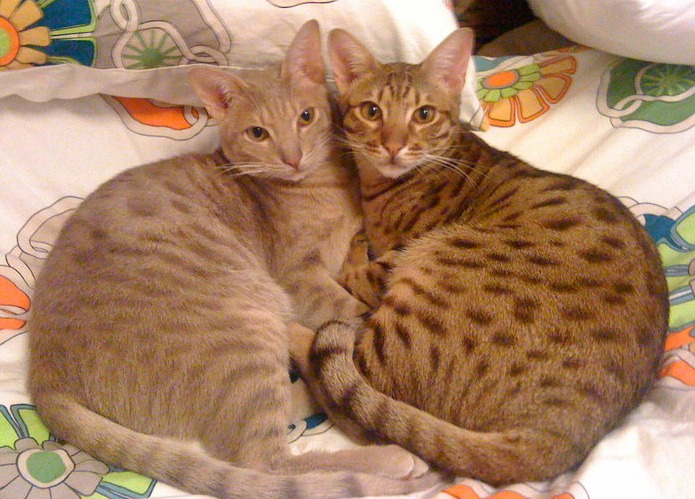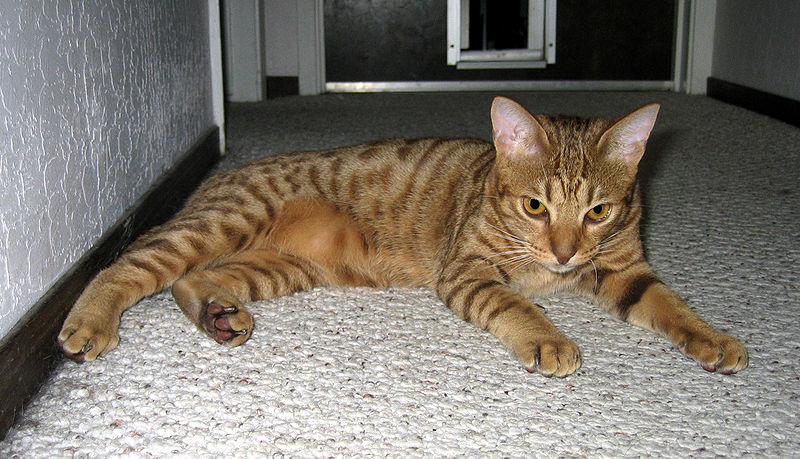The Ocicat is a domestic cat breed that resembles a wild cat but does not have any wild DNA in its gene pool. It means that even though this cat is spotted like a wild cat, it has the temperament of a domestic animal. Cat enthusiasts are always fascinated by spotted cats of the wild but never before was there such an effort to breed an entirely domestic cat which can offer the spotted beauty of the wild cats while maintaining the wonderful disposition of the domestic cat. Let us know more about the history and characteristics of the Ocicat cat breed.
History
Virginia Daly from Berkley, Michigan was the first breeder of Ocicats when she attempted to breed an Abyssinian-pointed Siamese in 1964. The resulting kittens appeared Abyssinian but the second generation ones, when she crossed one kitted with a Siamese, not only did she got an Aby-pointed Siamese but also one kitten who had an ivory-colored coat that is dotted with gold spots. She named the dotted cat Tonga, who is the first Ocicat to be born.
Tonga was neutered and sold as a pet. Further breeding of its parents produced more spotted kittens. These kittens became the basis of a separate Ocicat breeding program. There were other breeders who joined in and used the same process, Siamese to Abyssinian, and offspring to Siamese. Aside from that, American Shorthairs were also used to develop Ocicats to give them larger boning and to add silver to its six available colors.
In 1987, the Ocicat was accepted for registration by the Cat Fanciers’ Association, Inc. and the International Cat Association. It was also moved into Championship for showing. After that, other registries followed. The name Ocicat was given by Virginia’s daughter, Virginia E. Daly, because of its resemblance to the Ocelot. In the present time, the Ocicat can be found all around the world, being popular for its all-domestic temperament but wild appearance. It is also now recognized by all other cat registries.
Characteristics of an Ocicat
Average weight: 6 – 15 pounds
Life span: 10 – 15 years
Hypoallergenic: Yes
The Ocicat is popular for its spotted coat which gives it the look of a small wildcat. Its short, smooth, satiny coat comes in 12 colors and all of these feature dark thumbprint-shaped spots on a light background. The 12 colors approved by the CFA are chocolate, cinnamon, tawny, blue, lavender, fawn, black silver, chocolate silver, cinnamon silver, lavender silver, blue silver, and fawn silver. Just like its Abyssinian ancestors, it also has an agouti coat in which each hair has several bands of color except the tip of its tail and its spots are formed where those bands of colors meet.
The Ocicat has almond-shaped eyes, a strong body, muscular legs with dark markings, and powerful, oval-shaped paws. Its head has a wedge shape that is longer than wide and has tilted ears at a 45-degree angle. This cat breed is large and well-muscled, giving an impression of power and strength. Female Ocicats can weigh from 6 pounds to 9 pounds while males, on the other hand, can weigh from 9 pounds to 15 pounds.
Ocicats are playful and devoted pets. They love people and will always follow you around the house or might even ride on your shoulders. It can also welcome your guests because it is a sociable cat. They do not mind being carried around as long as they are with their humans. They love to play with puzzle toys, retrieving toys, and they can also learn to walk on a leash. It is also an intelligent cat that is capable of learning how to open doors and undo latches. It is also a vocal cat which it got from its Siamese ancestors, but it is not as loud or as demanding.
They are also well-suited to live with families with children. In fact, the Ocicat does not like being left alone, therefore, it will surely like to have your kids as its companion. It can play with your kids, learn tricks, and enjoy interactive toys as well. Aside from that, Ocicats can also leave well with cat-friendly dogs but it’s likely that they will dominate other cats and even dogs in the household, that’s why it’s better to slowly introduce any pets to them first.
Caring for an Ocicat
The Ocicat has a short coat that is very simple to groom. You can use a rubber curry brush on it weekly to remove dead hair and help distribute skin oils. Baths are rarely necessary for this cat breed unless you plan to show it. If you decide to bathe your pet, make sure to use a cat shampoo that will help enhance its gorgeous coat color.
The rest of the care it needs is basic care such as nail trimming every week, checking and cleaning the ears as needed, and brushing the teeth frequently. You can start these basic care early so that your kitten will become accepting of these activities.
When it comes to feeding your Ocicat, it’s best to consult your local veterinarian about the best foods you can give. How much food your pet needs depends on a lot of elements such as its age, activity level, metabolism, and physical activity. Always remember to give your pet fresh water daily to keep it hydrated.
To keep your Ocicat safe, it’s better to not let it go and play outdoors. You can simply build an area in your yard where it can jump and climb safely. This will prevent it from being attacked by other animals outside, from being stolen, and as well as from being hit by a car.


